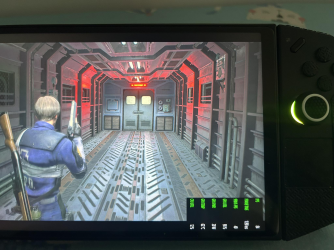The Lenovo Legion Go 2 was officially revealed at CES 2025 earlier this year, confirming that the new device would be launching later this year with the AMD Ryzen Z2 Extreme. Now, however, it seems as though prototype units of the Legion Go 2 have started leaking in China, with one Chinese content creator on Bilibili managing to publish a video review of the device on the social media platform. The reviewer gives us a look at the internals and specifications of the device, confirming that it will ship with a 144 Hz OLED display with a resolution of 1,920 × 1,200, a peak brightness of 500 nits, and 97% coverage of the DCI-P3 color space.
The review unit in question was apparently sold on a Chinese secondhand marketplace called GoFish after the production facility where it was produced shut down—according to one Redditor's claims, at least—and it apparently had the regular AMD Ryzen Z2 SoC, not the Z2 Extreme that is expected to power devices like the ASUS ROG Xbox Ally gaming handheld when that eventually launches. As expected, though, the Legion Go 2 features 32 GB of LPDDR5x-7500 memory and an AMD Radeon 780M iGPU. The battery capacity also seems to have been given a substantial upgrade to 74 Wh, compared to the 49.2 Wh in the original Legion Go. Judging by the stickers on the back of this particular pre-production unit, it was manufactured in November 2024, so there have likely been significant changes to the design and internals since then, and the information presented in the Bilibili video can be taken with a healthy helping of salt.

View at TechPowerUp Main Site | Source
The review unit in question was apparently sold on a Chinese secondhand marketplace called GoFish after the production facility where it was produced shut down—according to one Redditor's claims, at least—and it apparently had the regular AMD Ryzen Z2 SoC, not the Z2 Extreme that is expected to power devices like the ASUS ROG Xbox Ally gaming handheld when that eventually launches. As expected, though, the Legion Go 2 features 32 GB of LPDDR5x-7500 memory and an AMD Radeon 780M iGPU. The battery capacity also seems to have been given a substantial upgrade to 74 Wh, compared to the 49.2 Wh in the original Legion Go. Judging by the stickers on the back of this particular pre-production unit, it was manufactured in November 2024, so there have likely been significant changes to the design and internals since then, and the information presented in the Bilibili video can be taken with a healthy helping of salt.

View at TechPowerUp Main Site | Source




